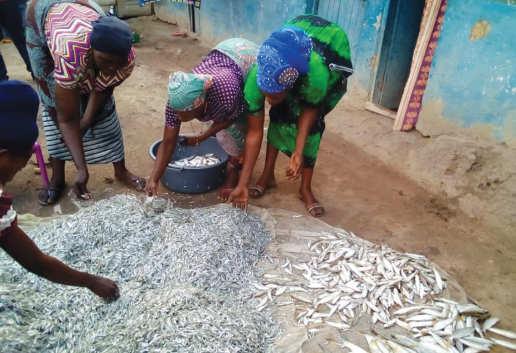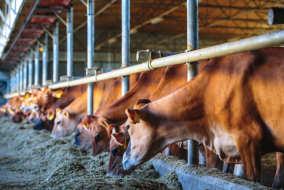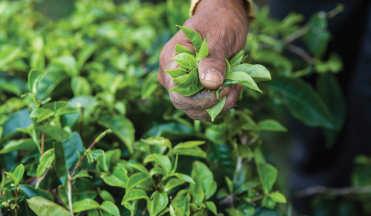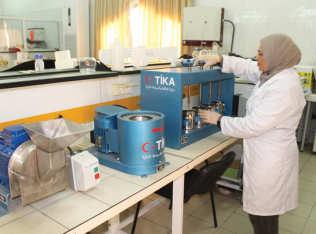
12 minute read
News
Farming Calendar 2022
AUGUST
29-2 Sep Africa AgriTech www.africa-agri.co.za
SEPTEMBER
13-15 Morocco Food Expo www.moroccofoodexpo.com
16-17 Naivasha Horticultural Fair www.naivashahortifair.com
OCTOBER
5-6 Poultry Africa www.poultryafricaevent.com
12-14 agrofood Kenya www.agrofood-kenya.com
27-29 Ethiopex & ALEC www.africanlivestock.net
PRETORIA
MOROCCO
NAIVASHA
KIGALI
NAIROBI
ADDIS ABABA
NOVEMBER
6-10 SIMA Paris www.m-en.simaonline.com.com
9-13 EIMA International www.eima.it
PARIS
BOLOGNA
15-18 EuroTier 2022 www.eurotier.com/en
HANOVER
29-1 Dec agrofood West Africa www.agrofood-westafrica.com
Readers should verify dates and location with sponsoring organisations, as this information is sometimes subject to change.
ACCRA
North and West Africa shares good practise for responsible agriculture investment
THE FAO-ITOCA REGIONAL event brought together 30 representatives from government and academic institutions, agri-entrepreneurs and agribusnesses, and non-governmental organisations from Liberia, Mauritania, Senegal, Sierra Leone and Tunisia.
“Enhancing responsible investment in agriculture that increases domestic production for food security; creates decent employment opportunities; and contributes to sustainable development is critical to recover from the effects of the COVID-19 pandemic and beyond,” said Andrew Nadeau, FAO senior capacity development officer during the event, which took place in Dakar on 29 and 30 June, 2022.
Celebrated under the banner of the Food and Agriculture Organization of the United Nations (FAO) and the Information, Training and Outreach Center for Africa (ITOCA), the event focused on empowering key change agents that can play a catalytic role in policy change related to agricultural investment.
Image Credit: Adobe Stock
30 representatives joined together to assess the landscape for responsible investment in the agricultural sector.
Fish project tackles malnutrition in Uganda

UGANDAN LAKE CATCHES are mostly dominated by three highlynutritious fishes, known locally as 'muziri', 'ragoogi' and 'mukene'. The fishes' nutritional and economic benefits are not yet being realised due to high post-harvest losses, caused by improper handling and processing techniques, which is impacting the quality and consumer appeal of the potential product.
The NutriFish project aims to correct these wrongs, optimising the catch's potential with nutrient-packed, fish-enriched products, including a cooking sauce and maize meal for mothers and babies.
The fish sauce, which can be used in place of beans as a protein source, cooks in just 10 minutes, compared to the one- to three-hour preparation required for beans. This enables local families to cut down on energy requirements and reduce environmental impact while meeting nutritional requirements.
NutriFish has engaged street vendors who make chapatti, normally served with beans, to encourage them to sell the flatbread with the fish-enriched sauce to increase uptake.
Anaemia is also being tackled, with the low-iron deficiency commonplace in Uganda. The condition affects women of reproductive age and children under five in particular, with these groups struggling to access animal products, especially fish, due to unavailability and expense.
NutriFish has introduced a solar tent drying technology as an alternative to traditional open-air sun-drying for the fish products. The tent drying process is faster and more hygienic than traditional methods, coming with a host of sustainable benefits, too. Processed fish quality has improved, increasing shelf life from six to eight weeks to nearly five months, doubling the incomes for the mostly female processers.
Local women now own seven boats themselves in the Ntoroko landing site on Lake Albert, enhancing their earnings to an estimated US$1,200 per month from fish-trading activities.
Image Credit: NutriFish
Local women have seen a monthly increase to US$1,200 from fish-trading activites, thanks to the NutriFish project.
Compostable crop sensors on the cards
AN INTERNATIONAL RESEARCH collaboration is planning to explore new ways of monitoring crop growth with biodegradable sensors which can be composted at the end of their lifespan.
The US$2.2mn CHIST-ERA project, called Transient Electronics for Sustainable ICT in Digital Agriculture, is led by researchers from the University of Glasgow and supported by colleagues in Canada, Finland, Poland and Switzerland. Over the next three years, the project partners will work together to develop a new type of environmentally-friendly modular sensor system.
The researchers aim to find ways to create devices built from sustainable and degradable materials with the aim of cutting down on the growing problem of electronic waste.
The devices will have two parts – a solar-powered patch which can be applied to the surface of the leaves of crops to measure key indicators of their growth and an electronic module which can wirelessly transmit the information collected by the patch to a central computer.
The team aims to make the patch completely biodegradable, and capable of nourishing the soil once it reaches the end of its period of usefulness. To do so, they will investigate how compostable electronic components might be made from everyday materials like rice husks, fibrous proteins like wool, or biodegradable polymers like starch or cellulose, combined with conductive metal nano particles made from materials like copper and zinc. It will also explore how those compostable components could be powered by similarly biodegradable organic photovoltaic materials to support the patch’s tasks of monitoring pH, temperature and bio-impedance, with energy stored in a biodegradable super capacitor. Super capacitors provide a sustainable, non-toxic alternative for conventional batteries.
At the same time, the team will also be working to develop an electronic module equipped with wireless communication technology. A key priority of the design for the module is that it will be reusable and repairable to help minimise waste.
Nutreco earns grant for sustainable feed solutions catering to small-scale producers
NUTRECO, A GLOBAL animal nutrition leader, has received a US$4.8mn grant from the Bill & Melinda Gates Foundation to accelerate the implementation of localised, sustainable complete feed production in sub-Saharan Africa, driving forward Nutreco’s purpose The grant will directly fund 21 Hendrix4U complete feed production projects. of ‘feeding the future’.
Compound feed production across the continent is some of the lowest in the world, and some of the most expensive due to inefficiencies and infrastructure challenges. As a result, small-scale livestock producers face declining incomes and uncertain futures, unless they gain access to quality animal feed.
The grant will directly fund 21 Hendrix4U complete feed production projects initially in Ghana, Ivory Coast, Nigeria and Uganda. Hendrix4U provides a ‘factory-in-a-box’ for rural areas ensuring access to quality compound feed production for small-scale producers, in a financially sustainable way.
Nutreco CEO Fulco van Lede said, “More than half of the projected global population growth in the coming decades will take place in Africa, and many will face food insecurity and hunger if no innovative solutions are developed to increase the sustainable production of food in the region. Today’s grant funding serves as validation of the work we are doing in Africa to equip producers with the right tools to future proof their livelihoods – and as a result, ensure high quality food and produce is accessible for communities throughout the continent.”

President Kenyatta urges KTDA to facilitate increased tea value addition
KENYA’S PRESIDENT UHURU Kenyatta has challenged the Kenya Tea Development Agency Holdings (KTDA) to initiate an elaborate plan that will ensure value addition to 90% of the tea grown in the country before it is exported.
He emphasised that tea farmers will reap maximum benefit from their labour if there is increased value addition to the tea they produce instead of selling it raw.
“The real future for tea is value adding 90% of our tea and finding direct markets from the farm to the one consuming the tea in a cup. That will be the long-term solution and that solution lies with you to set the foundation,” the President said. Apart from increasing the income of tea farmers, he said value addition will also help to create more jobs for the country’s youth.
Kenyatta announced this while addressing directors of the smallholder tea sub-sector where he also announced that this year the tea industry registered its best performance in the last five years. He added that the earnings of smallholder tea farmers increased by 42.4% in 2022 following the reforms initiated by the Government.
The President said the additional revenue, which will be paid to tea farmers, has risen by 44.6% in 2022. Noting that the rise of 76% is an average, he emphasised that each tea factory will pay specific rates based on its performance with some of the factories paying more than others.
President Kenyatta expressed optimism that the improved performance of the tea sub-sector this year will boost the hope of over 650,000 smallholder tea farmers and approximately 30% of Kenyans who are employed in the wider agricultural sector.
“I am confident that once the ongoing reforms are fully implemented, the tea industry will be fully revitalised for the benefit of the tea farmers and the country,” President Kenyatta said.
The President highlighted several key interventions that contributed to the increased earnings for the tea sub-sector including setting up of the minimum reserve price at the Mombasa tea auction in July 2021 that led to an increase in tea export earnings.

President Kenyatta said the real future is value adding 90% of the tea produced.
Image Credit: Adobe Stock
Intracare launches eco hoof bandage
INTRACARE, A DEVELOPER and supplier of products for veterinary health and nutrition, claims to have come up with the world’s most eco-friendly hoof bandage, which will be available worldwide soon.
The company has spent twoand-a-half years researching and developing an alternative biodegradable hoof bandage ‘Intra Eco Tape’, based on a natural fabric composition. The new bandage preserves its original properties such as a good stretchability, easy-tear and great adhesive properties. The product is packed ecologically without plastics and is produced without chemical colouring.
Besides the ecological benefits, Intra Eco Tape also offers the user greater value for money. One roll treats an average of three to four hooves while most offered products reach an average of two to three hooves.
West Africa Connect boosts region’s trade of mango, cassava, and ICT Services
AFTER A SUCCESSFUL edition in 2021, West Africa Connect (WestAfricaConnect.com) is back with a new event on September 20 and 21, 2022. This time, the focus is on promoting mangoes, cassava, and ICT services from West African suppliers to agribusiness buyers from West Africa, Africa, and other continents. Buyers can connect with over 150 selected fresh and processed mango and cassava suppliers as well as ICT service providers from 16 countries.
Throughout the event and thereafter, the platform will offer B2B meetings with partners and access to exhibitors’ digital profiles. Buyers can source from a wide range of regional products and services, benefitting from the tailored support provided by the organisers.
GLTC Rental ticks the right boxes for fruit season
FOR WESTERN CAPE fruit farmers, renting equipment from Goscor Lift Truck Company (GLTC) allows for on-time harvests without having to front the large capital cost of a down payment on mission-critical machinery. With that in mind, apple, grape and onion farmers in the in the Ceres/Grabouw area, Western Cape, are taking advantage of the flexible and cost-effective equipment rental facility from GLTC.
Janine Winterbach, GLTC Rental Sales Manager, said the company currently has a large fleet of machines out for the fruit season. GLTC has a wide variety of specs to offer, including the D25S-5 diesel model, the Doosan B25S-5 and Crown SC electric units. “The fleet is kept up to date, ensuring that customers have working machinery at all times without the threat of breakdowns or interruptions of work.”
Nigeria targets agro-processing as a future growth driver
AS NIGERIA LOOKS to restructure its economy to be more diversified and sustainable, agro-processing is emerging as a key tool to improve agricultural value added while also bolstering the sector’s status as a driver of economic growth.
As in many African countries, agriculture has long been an important part of Nigeria’s economy – not only in terms of food production, but also in terms of its economic impact and contribution to the overall workforce.
Despite its sizeable footprint, some 90% of agricultural goods are exported raw, meaning that the country misses out on crucial value-added opportunities associated with agro-processing.
It is estimated that up to 80% of profits in the agriculture sector are derived from processing and retailing raw goods. Emmanuel Ijewere, vice-president of the Nigeria Agribusiness Group and CEO of agro-processing firm best foods, estimated that for every dollar made exporting raw products in 2016, Nigeria could have earned 10-fold that value had the country processed all the commodities exported.
Economic impact
The lack of processing capacity means that Nigeria essentially exports its agricultural goods abroad, where they are processed and often exported back to Africa at a far higher price.
For example, it is estimated that between 2016 and 2019, Nigeria’s cumulative agricultural imports, at US$7.9bn, were four times higher than its agricultural exports.
As OBG has previously noted, such situations are not uncommon in the region. For example, leading West African cottonproducing nations Benin, Burkina-Faso and Mali export 1.8 million tonnes of unprocessed cotton worth US$922mn, but import $2.4bn of finished cotton textiles and apparel.
The result of such a model is that despite a large agriculture sector and vast arable land, Nigeria remains vulnerable to food insecurity and fluctuating food prices.
These challenges were underscored by the 2014 drop in oil prices that led to a recession in 2016. Amid falling revenue, the government sought to diversify the economy and reduce the import bill by focusing on agro-processing.

Development of agro-processing
In an effort to address the situation, in recent years Nigeria has sought to develop its agroprocessing capacity.
In 2015 the Central Bank of Nigeria launched the Anchor Borrowers’ Programme, an initiative to create linkages between smallholder farmers and agro-processors through a series of financing options and inputs.
The Bank of Industry (BoI), for its part, has supported the sector by providing loans aimed at developing the agriculture value chain. It is estimated that more than 6.9 million direct and indirect jobs were created through BoI initiatives between 2015 and October 2020.
It is estimated that up to 80% of profits in the agriculture sector are derived from processing and retailing raw goods.
TIKA Image Credit:

TIKA has established a chemical and molecular analysis laboratory.
TİKA supports Tunisia’s National Gene Bank
TURKISH COOPERATION AND Coordination Agency (TİKA) has established a chemical and molecular analysis laboratory for the identification, analysis, and registration of local fruit species, especially local olive tree species, within Tunisia’s National Gene Bank, affiliated with the Ministry of Environment of Tunisia. The project implemented by TİKA aims to ensure the conservation of olive, which accounts for a significant portion of Tunisia’s agricultural production and exports; to preserve olive trees for future generations; and to increase the added value. It will consist of four phases: the location of the exact position of local olive species and their harvesting (first phase), the characterisation and morphological analyses of these olive species (second phase), the registration of the analysed olive species in the database and their labeling (third phase), and the cultivation and distribution of high-yielding olive species in nurseries (fourth phase).







